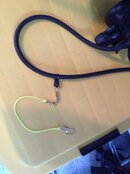your gear is appropriate for solo. If you own your own tanks, I would personally go to an H-valve instead of a pony because a first stage failure is more likely than actually running out of gas and will lighten the rig considerably, but a 19cf pony isn't really worth arguing about.
Echoing off of halocline above, the hogarthian and minimalist rigs are always assuming you are diving with a buddy. It is one of the fundamental principals of GUE/UTD/DIR etc etc, team diving is paramount. When you are solo diving, everything changes because now you have to carry the redundancy instead of your buddy.
Instead of a pocket on the bc, I would go with neoprene pocket shorts, or the dive rite thigh pockets. I personally don't carry an extra mask, but that is my choice and I am more comfortable without a mask on than with it on. Only thing I can't really do is read, which is solved by creating a small air bubble in your eye socket with your hand, or in the case of a lens failure, you can still get enough air in the mask pocket to read computer or tables. Odds of a lens failure are pretty slim, and if your strap is tethered, it is up to you whether or not you need one. Doesn't hurt to have though.
Only thing I'd really question is the wing size which will depend on how deep you're going and how thick your wetsuit is. You have 20lbs lost to gas, so 12lbs may or may not be enough to compensate for your suit, but you also have to total up the weight of everything else you're carrying. I'd argue you're probably pretty close to maxing out the wing, so that would be the only thing I'd verify.




